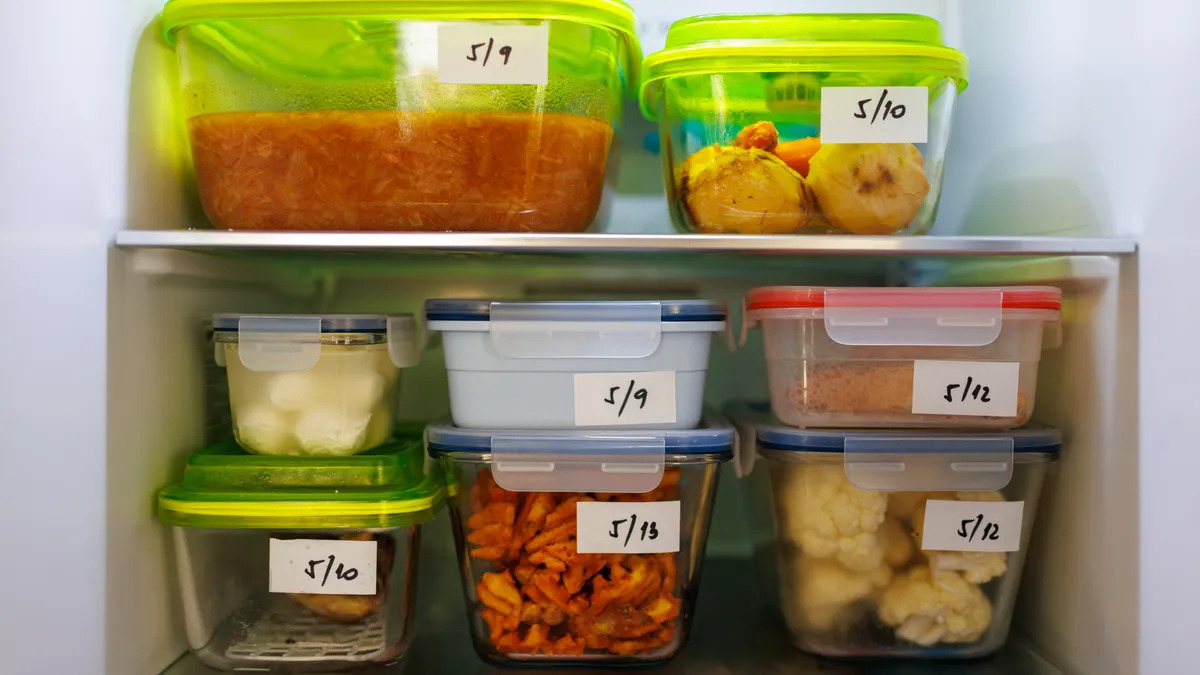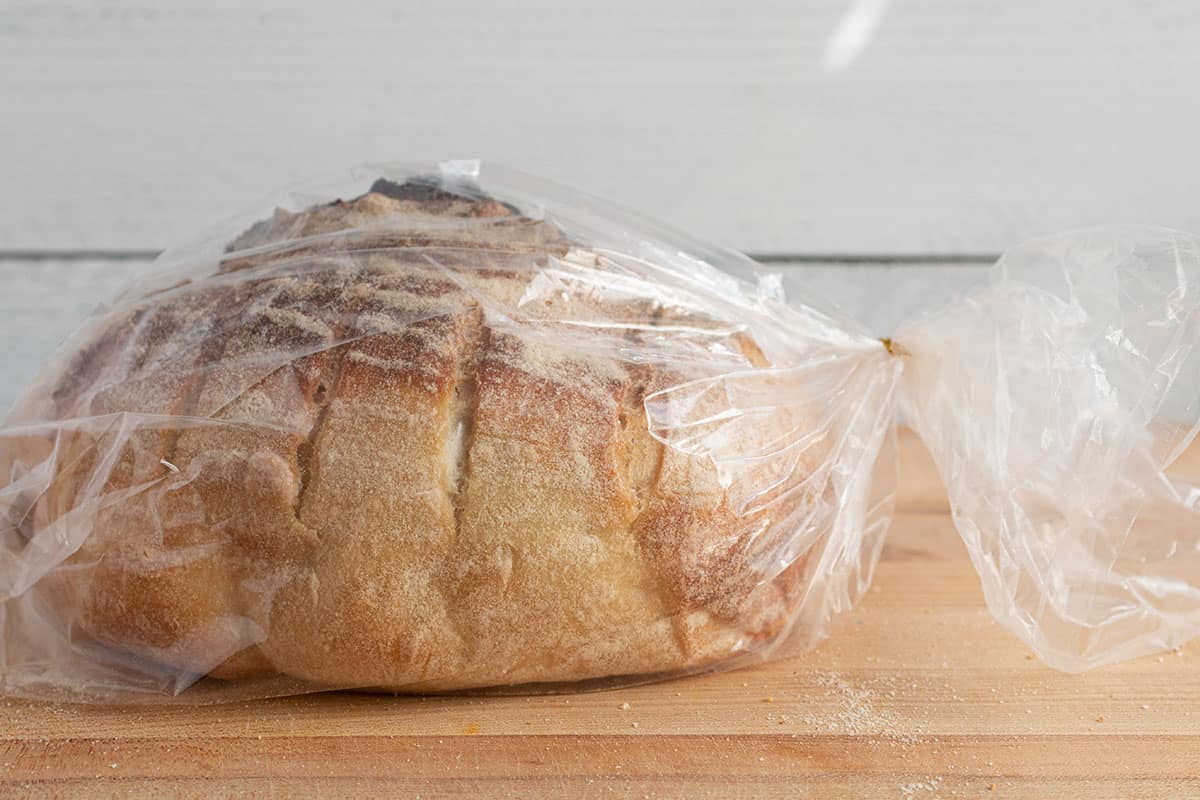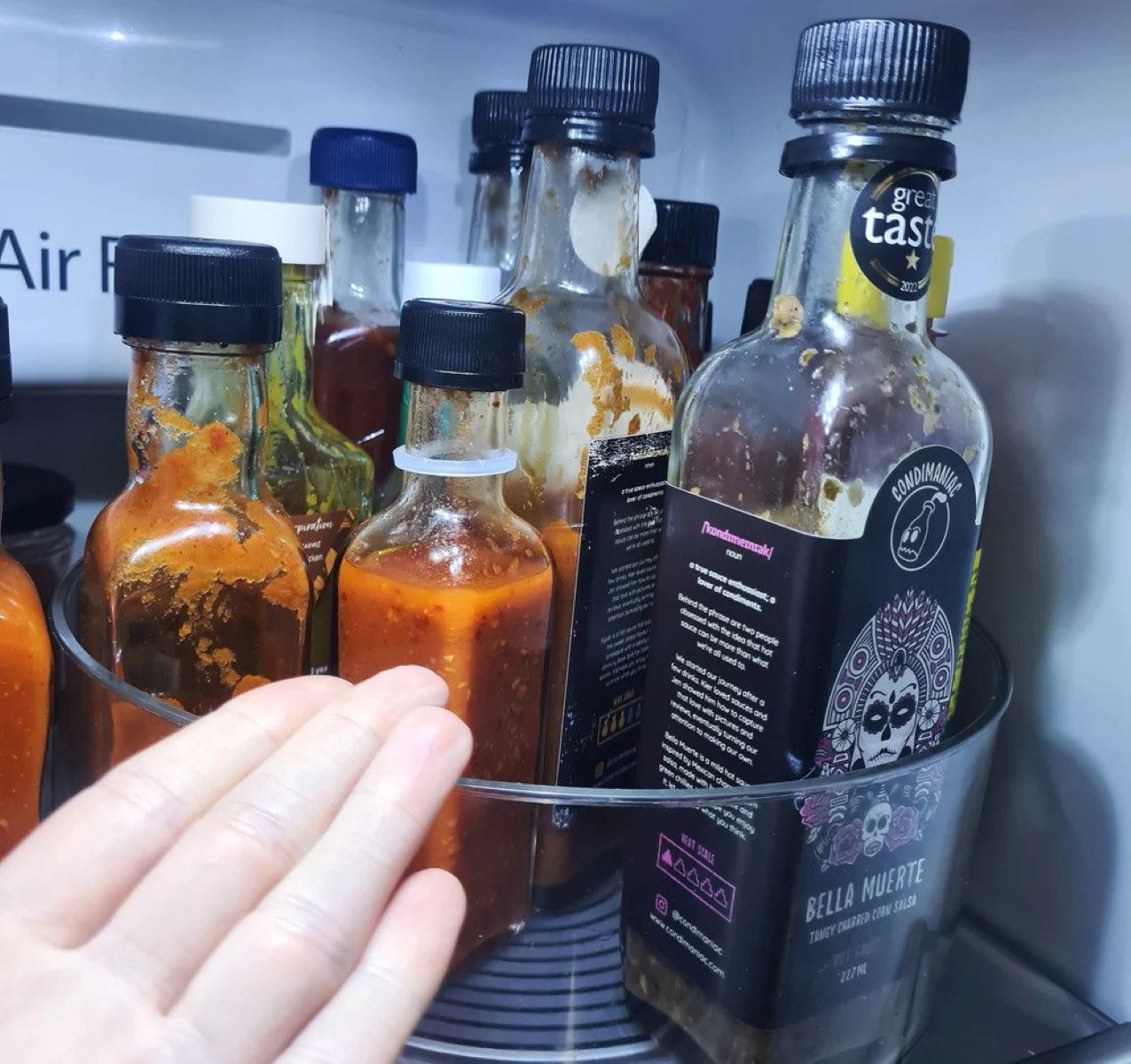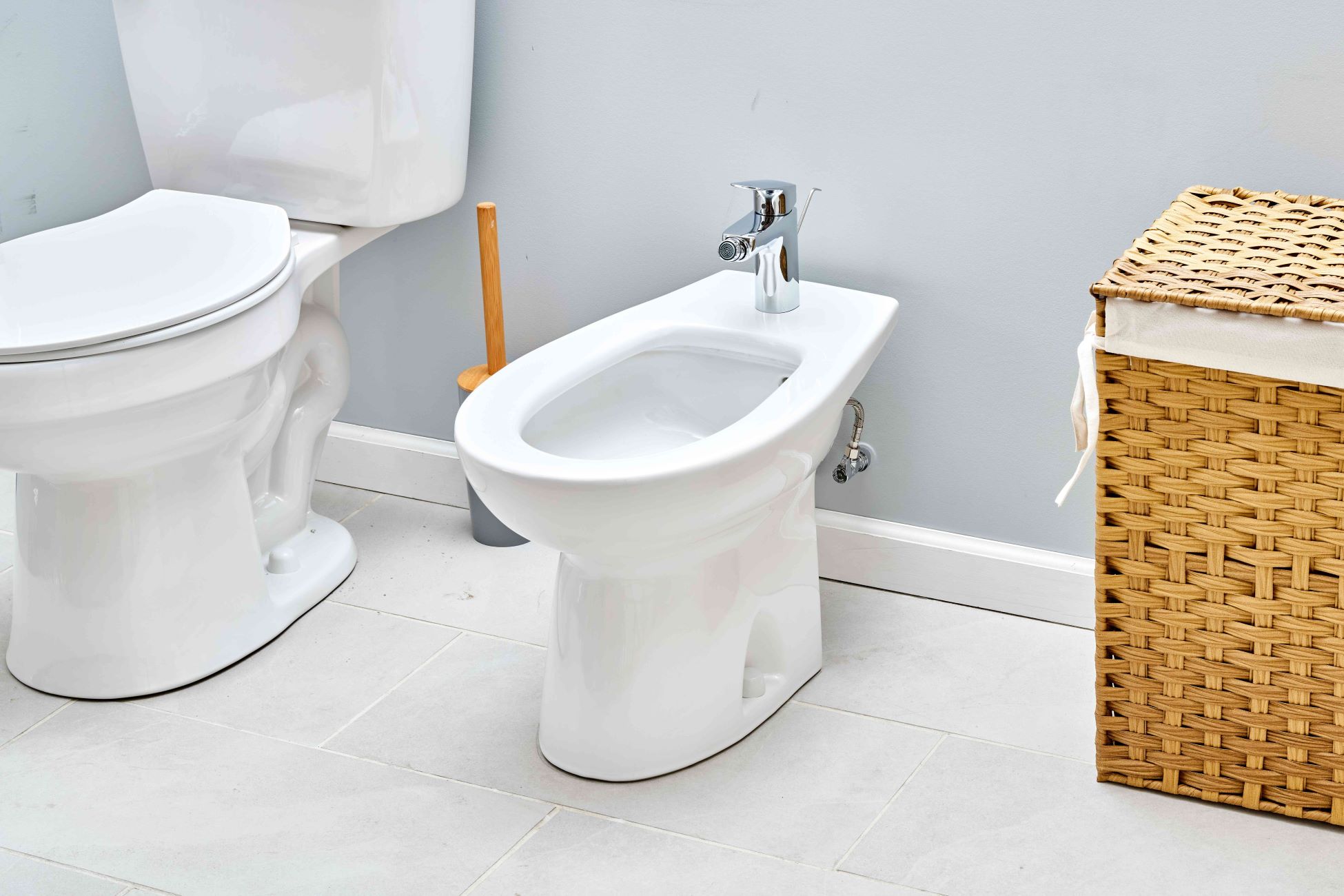

Articles
How To Store Food Properly
Modified: October 20, 2024
Learn how to store food properly and ensure its freshness with these informative articles. Discover tips and tricks for effective food storage and avoid spoilage.
(Many of the links in this article redirect to a specific reviewed product. Your purchase of these products through affiliate links helps to generate commission for Storables.com, at no extra cost. Learn more)
Introduction
Proper food storage is essential for maintaining the quality, freshness, and safety of our food. Whether you’re storing fresh produce, perishable items, dry goods, or leftovers, there are certain guidelines that should be followed to ensure optimal storage conditions. By storing food correctly, you can reduce the risk of foodborne illnesses, minimize food waste, and extend the shelf life of your groceries.
In this article, we will explore the importance of proper food storage and provide you with practical tips and guidelines for storing different types of food. Whether you’re a seasoned chef or a home cook, understanding how to store food properly will help you make the most of your ingredients, save money, and create delicious meals with peace of mind.
So why is it crucial to store food properly in the first place? First and foremost, improper food storage can lead to the growth of harmful bacteria, such as Salmonella and E. coli, which can cause foodborne illnesses. These illnesses can result in symptoms like nausea, vomiting, diarrhea, and even more severe complications for vulnerable populations such as children, elderly individuals, and those with weakened immune systems.
Furthermore, proper food storage helps to maintain the nutritional value of the food. Certain vitamins and minerals are sensitive to heat, light, and air exposure, so by storing food correctly, you can preserve its nutritional content and ensure you’re getting the maximum benefit from your meals.
Finally, storing food properly reduces food waste. When food is stored improperly and spoils quickly, it often ends up in the trash. This not only wastes money but also contributes to environmental issues such as methane emissions from landfills. By following proper storage guidelines, you can reduce food waste and make a positive impact on the environment.
Now that we understand the importance of proper food storage, let’s explore some general guidelines that apply to most types of food. These guidelines will help ensure that your food stays fresh, safe, and flavorful for as long as possible. So let’s dive in and discover the best practices for storing your food!
Key Takeaways:
- Proper food storage is crucial for maintaining freshness, safety, and nutritional value. Following guidelines for temperature control, airtight containers, and organization can minimize waste and reduce the risk of foodborne illnesses.
- Understanding expiration dates, proper freezing and thawing techniques, and food safety tips are essential for maintaining the integrity and safety of stored food. By following these practices, you can enjoy fresh, flavorful meals while minimizing waste and ensuring food safety.
Read more: How To Properly Store Tofu
Understanding the Importance of Proper Food Storage
Proper food storage is not just a matter of convenience; it is essential for our health and well-being. By storing food properly, we can prevent foodborne illnesses, reduce food waste, and maintain the quality and nutritional value of our food.
One of the key reasons why it is crucial to store food properly is to prevent the growth of harmful bacteria. Bacteria such as Salmonella and E. coli can multiply rapidly in food that is stored at unsafe temperatures or exposed to cross-contamination. These bacteria can cause foodborne illnesses, leading to symptoms like stomach cramps, diarrhea, and vomiting.
Proper food storage also helps to extend the shelf life of our groceries, which in turn reduces food waste. When food is stored correctly, it stays fresher for longer, minimizing the need to throw away spoiled or expired items. By reducing food waste, we can not only save money but also contribute to environmental sustainability by reducing the amount of food that ends up in landfills.
In addition to preventing illness and reducing waste, proper food storage helps maintain the quality and nutritional value of our food. Exposure to air, light, and heat can lead to nutrient loss, oxidation, and spoilage of perishable items. By storing food in appropriate conditions, such as keeping it refrigerated or in airtight containers, we can preserve the taste, texture, and nutrients of our food for longer periods.
Another significant benefit of proper food storage is that it allows for better meal planning and organization. When food is stored in a well-organized manner, it is easier to keep track of what we have and avoid double purchases. This not only saves money but also ensures that we use up our ingredients before they go bad.
Lastly, storing food properly helps us save time and effort in our daily cooking routines. When ingredients are properly stored, they are readily available, fresh, and in good condition, making meal preparation more efficient and enjoyable. It also encourages us to experiment with new recipes and reduce reliance on processed or takeout food.
Overall, understanding the importance of proper food storage is crucial for our health, sustainability, and overall enjoyment of meals. By following simple guidelines and adopting good practices, we can ensure that our food remains safe, fresh, and full of nutrients. In the following sections, we will delve deeper into specific guidelines for storing different types of food to help you make the most out of your ingredients and reduce food waste.
General Guidelines for Food Storage
When it comes to storing food properly, there are a few general guidelines that apply to most types of food. By following these guidelines, you can ensure that your food stays fresh, safe, and organized. Let’s explore these guidelines in detail.
Keeping food at the right temperature: Temperature control is critical for food safety. Perishable foods like meat, poultry, dairy products, and certain fruits and vegetables should be stored in the refrigerator at a temperature of 40°F (4°C) or below. This helps slow down the growth of bacteria. Freezers should be set at 0°F (-18°C) or below to maintain the quality and taste of frozen foods.
Utilizing airtight containers for storage: To keep your food fresher for longer and to prevent moisture and odors from affecting other foods, it is essential to use airtight containers for storage. Plastic containers with tight-fitting lids, glass jars with rubber seals, and resealable plastic bags are all excellent options for storing various types of food.
Avoiding cross-contamination: Cross-contamination can occur when bacteria from one food item spreads to another, leading to foodborne illnesses. To prevent cross-contamination, it’s important to keep raw meat, poultry, and seafood separate from other foods. Use separate cutting boards and utensils for raw and cooked foods, and always wash your hands thoroughly after handling raw ingredients.
Labeling and organizing food items: Proper labeling and organization can help you keep track of your food and prevent wastage. Label containers with the date of storage to ensure that you use the oldest items first. It is also helpful to organize your fridge and pantry, placing the oldest items in the front for easy access and visibility.
By following these general guidelines for food storage, you can maintain the freshness and quality of your food while minimizing the risk of foodborne illnesses. In the following sections, we will delve deeper into specific tips for storing different types of food, including fresh produce, perishable items, dry goods, and leftovers.
Storing Fresh Produce
Fresh produce is a staple in a healthy diet, but it can be tricky to store properly to maintain its freshness and extend its shelf life. Here are some guidelines for storing different types of fruits and vegetables:
Refrigeration guidelines for different fruits and vegetables:
- Leafy greens: Remove any rubber bands or twist ties and store them in a breathable bag or container with a slightly damp paper towel to maintain moisture.
- Root vegetables (carrots, beets, radishes): Remove the greens and store them separately. Place the vegetables in a perforated plastic bag or a container with a lid in the refrigerator.
- Tomatoes: Keep them at room temperature away from direct sunlight until they are fully ripe. Once ripe, move them to the refrigerator to prolong their shelf life.
- Citrus fruits: Store them at room temperature if you plan to consume them within a few days. Otherwise, refrigerate them to extend their shelf life.
- Berries: Store them unwashed in a breathable container lined with paper towels to absorb excess moisture. Keep them refrigerated.
- Apples and pears: Store them in a cool, dry place away from other fruits and vegetables. They can be refrigerated, but this may affect their texture.
- Potatoes and onions: Keep them in a cool, dark place with good ventilation. Avoid storing potatoes near onions, as they can accelerate each other’s spoilage.
Tips for maximizing the shelf life of fresh produce:
- Wash fruits and vegetables just before you plan to eat or cook them. Washing them beforehand can promote spoilage and reduce their shelf life.
- Remove any damaged or spoiled pieces of produce from the rest to prevent the spread of molds and bacteria.
- Do not store ripe and unripe fruits together, as the ethylene gas emitted by ripe fruits can accelerate the ripening process of unripe ones.
- Keep fruits and vegetables separate, as some fruits release ethylene gas, which can cause vegetables to deteriorate faster.
- Consider blanching and freezing certain vegetables for long-term storage, especially if you have a surplus. Blanching helps preserve the color, texture, and nutritional value of the vegetables.
By following these guidelines and taking proper care of your fresh produce, you can extend their shelf life, reduce waste, and enjoy the full nutritional benefits of these wholesome ingredients. In the next section, we will explore the proper storage of perishable foods such as dairy products, meat, and poultry.
Storing Perishable Foods
When it comes to perishable foods like dairy products, meat, and poultry, proper storage is crucial to maintain their safety and quality. Here are some guidelines for storing these perishable items:
Properly storing dairy, meat, and poultry products:
- Dairy products: Most dairy products, such as milk, yogurt, and cheese, should be stored in the refrigerator at temperatures below 40°F (4°C). Keep them in their original packaging or transfer them to airtight containers to prevent moisture and odors from affecting other foods.
- Meat: Raw meat, including beef, pork, lamb, and poultry, should be stored in the coldest part of the refrigerator, usually the bottom shelf. For longer storage, consider wrapping the meat in plastic wrap or placing it in a sealed plastic bag to prevent the leakage of juices.
- Poultry: Store raw poultry, such as chicken or turkey, on the bottom shelf of the refrigerator, away from other foods. It’s best to keep poultry in its original packaging, but if you need to repackage it, ensure it is tightly sealed to prevent cross-contamination.
Tips for preventing spoilage and extending shelf life:
- Check meat and poultry for any signs of spoilage before storing and consuming. Look for discoloration, unusual odors, or sliminess.
- Keep a separate area in the refrigerator for raw meat and poultry to avoid cross-contamination with other food items.
- Follow the “first in, first out” rule, meaning use the oldest meat or poultry products before newer ones to ensure freshness.
- If you have leftovers, refrigerate or freeze them promptly to prevent bacterial growth.
- Ensure that your refrigerator is set at the appropriate temperature to maintain the freshness of perishable items.
- Regularly clean and sanitize your refrigerator to prevent the growth of bacteria and eliminate any lingering odors.
By properly storing perishable foods, you can prevent spoilage, maintain their quality and safety, and minimize waste. These guidelines will help you make the most out of your dairy products, meat, and poultry, ensuring that you enjoy them at their best. In the next section, we will delve into the proper storage of dry goods such as grains, cereals, and legumes.
Read more: How To Store Books Properly
Storing Dry Goods
Proper storage of dry goods such as grains, cereals, and legumes is essential to maintain their freshness, prevent spoilage, and avoid pest infestation. Here are some guidelines for storing these pantry staples:
Guidelines for storing pantry staples:
- Store dry goods in a cool, dark, and dry place to prevent moisture and heat from causing spoilage and mold growth.
- Transfer items from their original packaging into airtight containers, such as glass jars or plastic containers with tight-fitting lids, to protect them from pests and maintain their freshness.
- Label containers with the name of the product and the date of storage to easily identify and rotate your stock based on age.
- Keep similar items together and organize them by category, making it easier to find and use what you need.
- Consider storing grains, cereals, and legumes away from strong-smelling spices or cleaning products, as they can absorb odors.
Tips for preventing pests and maintaining freshness:
- Inspect dry goods before storing them to ensure that they are free from any signs of infestation or damage.
- Place bay leaves or whole cloves in the storage containers to help repel pantry pests like weevils and beetles.
- For added protection, you can freeze grains, cereals, and legumes for a few days before transferring them to storage containers. This helps kill any eggs or larvae that may be present.
- Avoid storing dry goods near areas prone to high humidity or temperature fluctuations, such as near the stove or dishwasher, as this can accelerate spoilage and promote pest activity.
- Regularly inspect your pantry for any signs of pests, such as tiny holes in packaging or insect droppings. If an infestation is detected, remove and discard infested items immediately.
By following these guidelines and taking precautions to prevent pests and maintain freshness, you can ensure that your pantry staples remain in good condition and are ready to use when needed. Proper storage of dry goods will not only save you from wasting food but also save money by extending their shelf life. In the next section, we will explore the proper storage of leftovers and how to safely reheat them.
Store raw meat, poultry, and seafood in the coldest part of the fridge to prevent bacteria growth. Use airtight containers for leftovers to maintain freshness.
Storing Leftovers
Leftovers can be a convenient and delicious way to enjoy meals again. However, it is essential to store and reheat them properly to maintain their safety and quality. Here are some guidelines for storing leftovers:
How to store leftovers safely:
- Allow hot food to cool down before storing it in the refrigerator or freezer. Leftovers should be stored within two hours of cooking to prevent bacterial growth.
- Divide large portions of leftovers into smaller, shallow containers to cool them quickly and evenly. This helps prevent the growth of harmful bacteria.
- Wrap or cover the leftovers tightly with plastic wrap, foil, or in airtight containers to prevent moisture loss and protect them from absorbing odors from other foods in the refrigerator.
- Label containers with the date of storage to keep track of their freshness. Most leftovers can be safely stored in the refrigerator for 3-4 days, but if in doubt, you can always check the USDA’s guidelines for specific food items.
- For longer storage, transfer leftovers to the freezer. Most cooked foods can be safely stored in the freezer for up to 3 months. Freezing leftovers promptly helps maintain their quality and flavor.
Tips for reheating leftovers:
- When reheating leftovers, ensure that they reach an internal temperature of 165°F (74°C) to kill any bacteria that may have grown during storage.
- Reheat leftovers using the stovetop, microwave, or oven, depending on the type of food. Ensure that the reheating process is thorough and even to eliminate any cold spots.
- Avoid reheating food more than once, as each reheating can diminish the quality and increase the risk of bacterial growth.
- Discard any leftovers that have a peculiar smell, taste, or texture, as they may indicate spoilage.
Understanding the time limits for different types of foods is essential to ensure their safety. While most leftovers can be refrigerated for a few days, it’s important to note that some items, such as seafood and dairy-based dishes, have shorter storage times. Always use your judgment and consider the specific characteristics of each dish when deciding whether to keep or discard leftovers.
By following these guidelines for storing and reheating leftovers, you can reduce food waste, enjoy meals again, and ensure that your food remains safe and delicious. In the next section, we will explore the proper techniques for freezing and thawing foods.
Freezing and Thawing Foods
Freezing is an excellent method for preserving the freshness and extending the shelf life of various foods. However, it’s important to follow proper techniques for freezing and thawing to maintain the quality and safety of the items. Here are some guidelines to help you freeze and thaw foods effectively:
Proper techniques for freezing food:
- Wrap or package food items tightly in freezer-safe containers or bags to prevent freezer burn and protect against moisture and air exposure.
- Remove excess air from freezer bags before sealing them to minimize the risk of freezer burn and maintain the quality of the food.
- Divide large portions of food into smaller, individual portions before freezing for easier thawing and quicker reheating.
- Label containers with the name of the food item and the date of freezing to ensure you use the oldest items first.
- Always cool cooked foods before freezing them to avoid raising the temperature of the freezer and potentially compromising the quality of other frozen items.
- Ensure that the freezer maintains a temperature of 0°F (-18°C) or below to keep the food frozen solid and prevent bacterial growth.
Safely thawing frozen items:
- The best way to thaw frozen food is to transfer it from the freezer to the refrigerator and allow it to thaw slowly and safely. This method preserves the quality and minimizes the risk of bacterial growth.
- If you need to thaw food more quickly, you can place it in a sealed plastic bag and submerge it in cold water. Change the water every 30 minutes to ensure it remains cold.
- When using the microwave to thaw food, follow the manufacturer’s instructions and use the defrost setting. Be cautious to avoid starting the cooking process unintentionally.
- Avoid thawing food at room temperature, as this can allow the growth of harmful bacteria. If you accidentally left food out at room temperature for more than 2 hours, it is safer to discard it.
By using proper techniques for freezing and thawing foods, you can preserve their quality, retain their nutritional value, and safely enjoy them at a later time. Freezing is a convenient method for preserving a variety of food items, allowing you to minimize waste and always have ingredients on hand when needed. In the next section, we will explore expiration dates and the shelf life of different foods.
Understanding Expiration Dates and Food Shelf Life
Deciphering food expiration labels and understanding the shelf life of various food items is important for ensuring their freshness, quality, and safety. Let’s explore how to make sense of expiration dates and how to determine the freshness and quality of different foods:
Deciphering food expiration labels:
- “Best Before” or “Best By” Date: This indicates the date until which the food is expected to retain its optimal quality and flavor. It is not a safety date, and the food may still be edible after this date.
- “Use By” or “Expiry” Date: This is the date until which the manufacturer suggests using the food for peak quality and safety. Foods should be consumed or discarded by this date to minimize the risk of foodborne illnesses.
- “Sell By” Date: This is the date by which the retailer should sell the product to ensure the customer has enough time to consume it at its best quality. It does not necessarily indicate that the food is no longer safe to eat after this date.
Tips for determining the freshness and quality of various food items:
- Inspect the appearance, color, and texture of perishable items. Discoloration, mold growth, or signs of spoilage indicate that the food may no longer be safe to consume.
- Pay attention to the smell of the food. Any unusual or foul odors could indicate spoilage.
- For packaged foods, check for signs of damage, such as dented cans, broken seals, or popped lids. Damaged packaging can compromise the quality and safety of the contents.
- When it comes to perishable goods, trust your senses. Trusting your instincts regarding the freshness of food can help prevent the consumption of potentially spoiled items.
- If food has been stored properly and is within the expiration or best before date, it is likely safe to consume. However, if you have any doubts, it is always better to err on the side of caution and discard the item.
Understanding expiration dates and the shelf life of different foods helps ensure that you consume them at their best quality and reduce the risk of foodborne illnesses. While expiration dates can provide guidance, it’s important to rely on your senses and proper storage practices to assess the freshness and quality of food. In the next section, we will discuss important food storage safety tips to prevent foodborne illnesses.
Read more: How To Store Eggs Properly
Food Storage Safety Tips
Proper food storage is essential for preventing foodborne illnesses and maintaining the safety of the food we consume. By following these food storage safety tips, you can reduce the risk of contamination and ensure the health and well-being of yourself and your loved ones:
Important practices to prevent foodborne illnesses:
- Wash your hands thoroughly with soap and water before handling food. This helps eliminate bacteria and prevent cross-contamination.
- Keep raw meats, poultry, seafood, and their juices separate from other foods to prevent the spread of harmful bacteria. Use separate cutting boards, utensils, and containers for different types of food.
- Store raw meats securely on the lowest shelf of the refrigerator to prevent cross-contamination with other foods. Consider placing them in a leak-proof container or on a tray to catch any juices.
- Ensure that your refrigerator and freezer are operating at the correct temperatures to inhibit bacterial growth. The refrigerator should be set at 40°F (4°C) or below, while the freezer should be at 0°F (-18°C) or below.
- Thaw frozen food safely by transferring it to the refrigerator or using the cold water method. Avoid thawing food at room temperature, as this can promote the growth of harmful bacteria.
- Refrigerate or freeze perishable items promptly to prevent bacterial growth. Food left at room temperature for more than two hours (or one hour in temperatures above 90°F/32°C) should be discarded.
- Regularly clean and sanitize kitchen surfaces, cutting boards, utensils, and containers to eliminate any bacteria that may be present.
Common mistakes to avoid when storing food:
- Avoid storing hot or warm food directly in the refrigerator. Allow it to cool down to room temperature before refrigerating to prevent temperature fluctuations.
- Do not overload the refrigerator or freezer, as this can impede proper air circulation and compromise the effectiveness of cooling and freezing.
- Never reuse packaging materials, such as plastic bags or containers, that were used to store raw meats or other potentially contaminated foods. Use fresh, clean packaging for storage.
- Do not taste food that is past its expiration date or shows signs of spoilage. Trust your senses and discard any food that seems questionable.
- Avoid storing leftovers for an excessive amount of time, even if they appear and smell fine. It’s best to follow the recommended storage times for each type of food to ensure safety.
By practicing proper food storage techniques and avoiding common mistakes, you can significantly reduce the risk of foodborne illnesses and create a safe environment for your food. Remember to always prioritize hygiene and adhere to food safety guidelines. With these tips in mind, you can confidently store your food and enjoy it with peace of mind knowing that it’s safe and enjoyable.
Conclusion
Proper food storage is crucial for maintaining the freshness, quality, and safety of our food. By following the guidelines and tips discussed in this article, you can ensure that your food stays safe, flavorful, and nutritious for longer periods. Understanding the importance of proper food storage helps to prevent foodborne illnesses, reduce food waste, and save money. Whether you’re storing fresh produce, perishable items, dry goods, or leftovers, there are specific practices that should be followed to maximize the shelf life and maintain the integrity of the food.
From refrigeration guidelines for different fruits and vegetables to the proper storage of dairy, meat, and poultry products, each type of food requires specific attention to ensure its safety and quality. By utilizing airtight containers, avoiding cross-contamination, and labeling and organizing food items, you can create an efficient and well-maintained storage system. Additionally, understanding expiration dates, deciphering food labels, and determining the freshness of different foods helps you make informed decisions about their suitability for consumption.
Implementing the correct techniques for freezing and thawing foods is crucial for preserving their quality and flavor. By using proper storage containers, labeling items, and maintaining the appropriate freezer temperature, you can preserve the freshness and extend the shelf life of many foods. Thawing frozen items safely, whether in the refrigerator or using other approved methods, ensures that the food remains free from harmful bacteria.
By observing food storage safety tips like hand hygiene, preventing cross-contamination, and maintaining proper storage temperatures, you can minimize the risk of foodborne illnesses and keep your kitchen and food items safe. Avoiding common mistakes such as overloading the refrigerator, tasting spoiled food, and storing leftovers for excessive periods helps maintain the integrity and safety of the stored food. Regularly cleaning and sanitizing surfaces, utensils, and storage containers is also essential for preventing bacterial growth and maintaining a hygienic kitchen environment.
In conclusion, proper food storage is not just about convenience or organizational skills; it is essential for our health, well-being, and the well-being of our planet. By implementing the guidelines and best practices shared in this article, you can take control of your food storage, minimize waste, reduce the risk of foodborne illnesses, and enjoy fresh, delicious meals with peace of mind.
Frequently Asked Questions about How To Store Food Properly
Was this page helpful?
At Storables.com, we guarantee accurate and reliable information. Our content, validated by Expert Board Contributors, is crafted following stringent Editorial Policies. We're committed to providing you with well-researched, expert-backed insights for all your informational needs.














0 thoughts on “How To Store Food Properly”